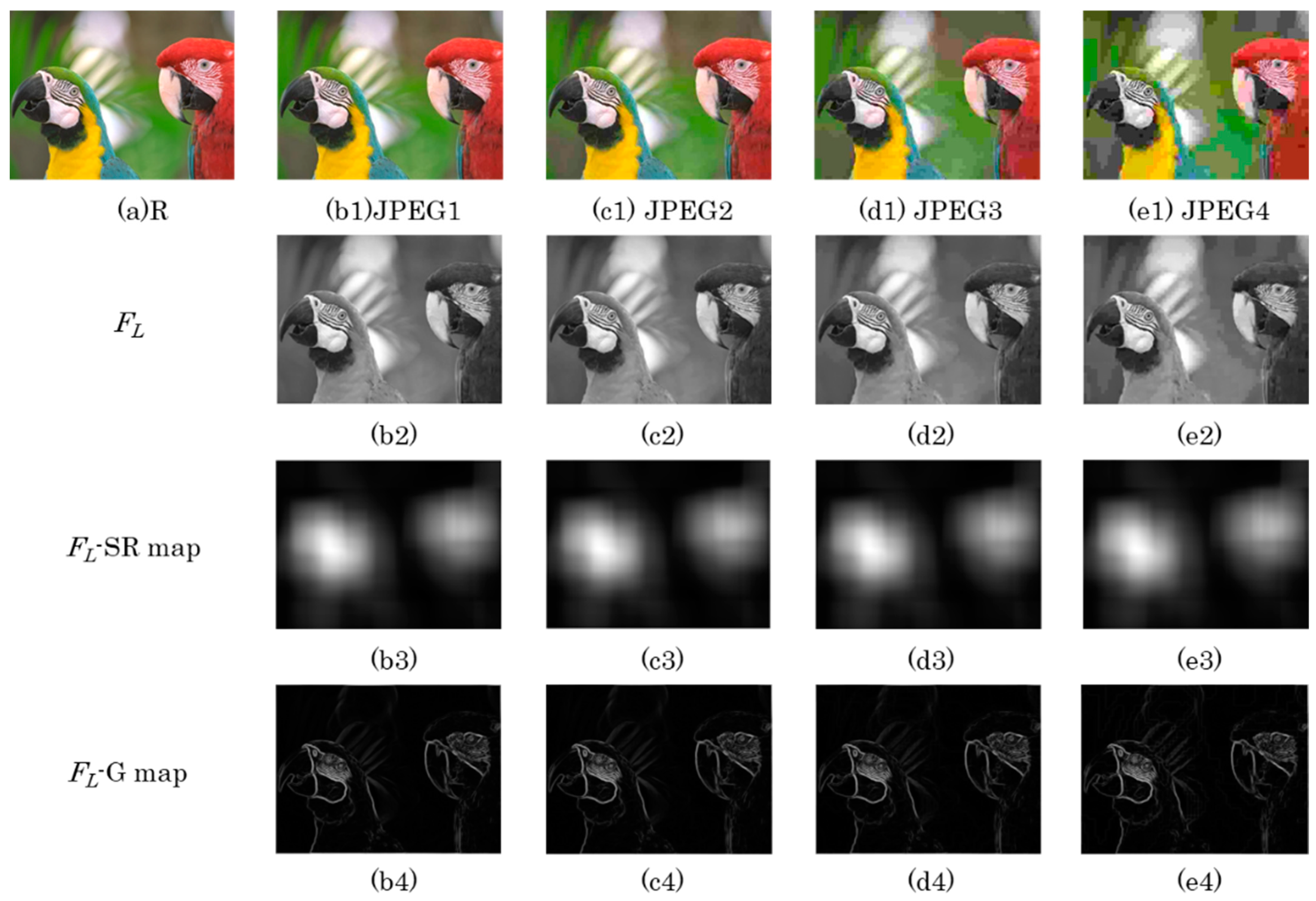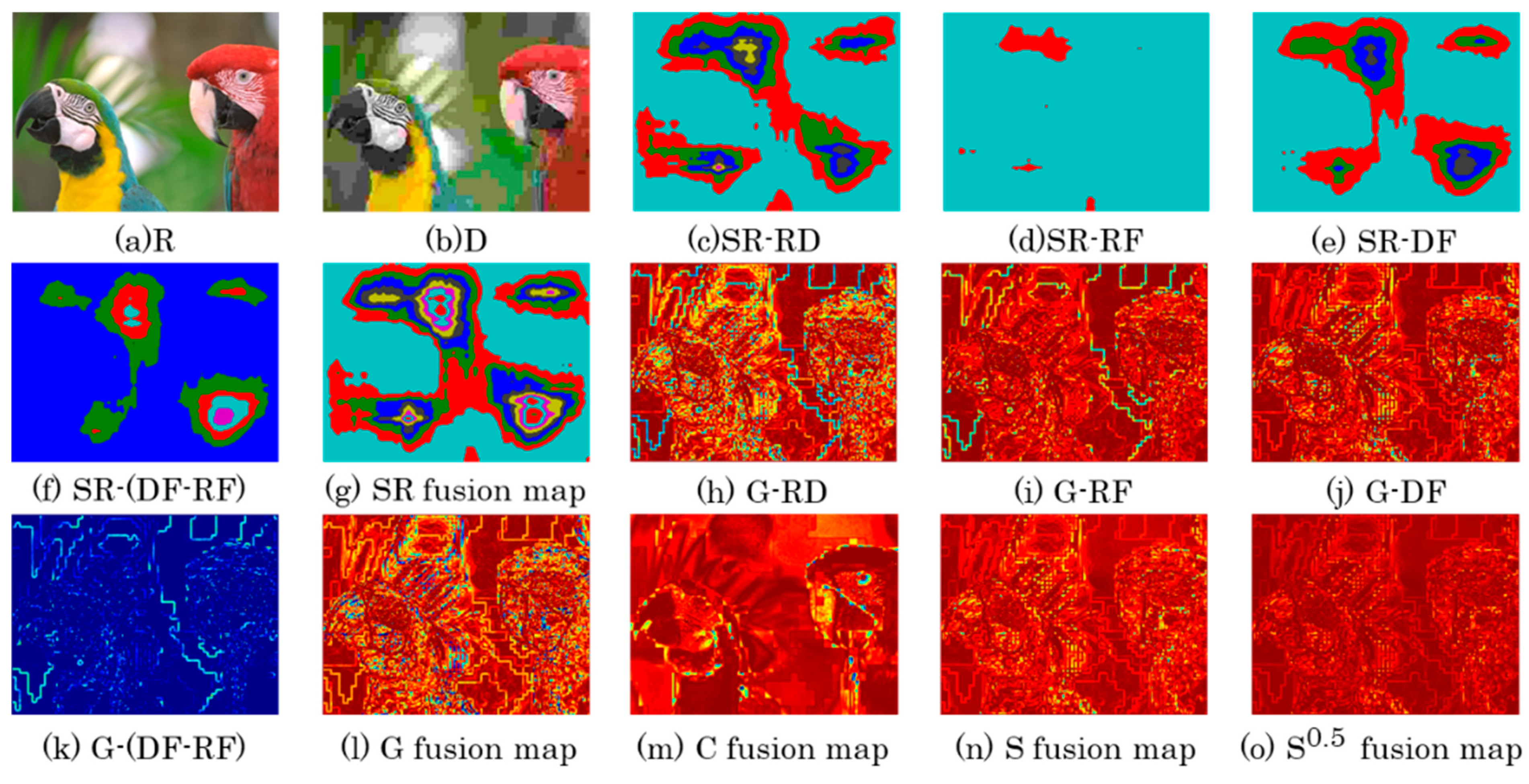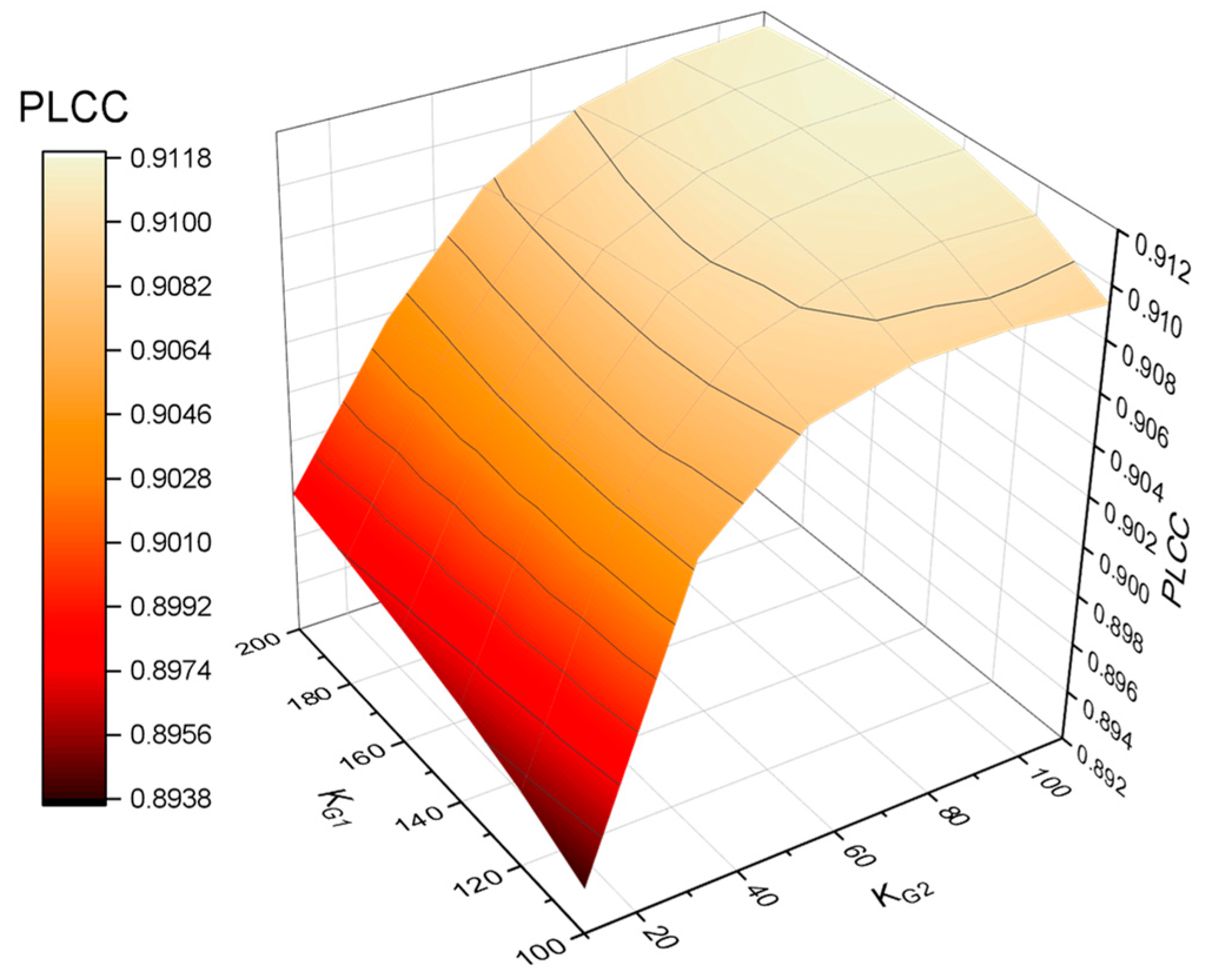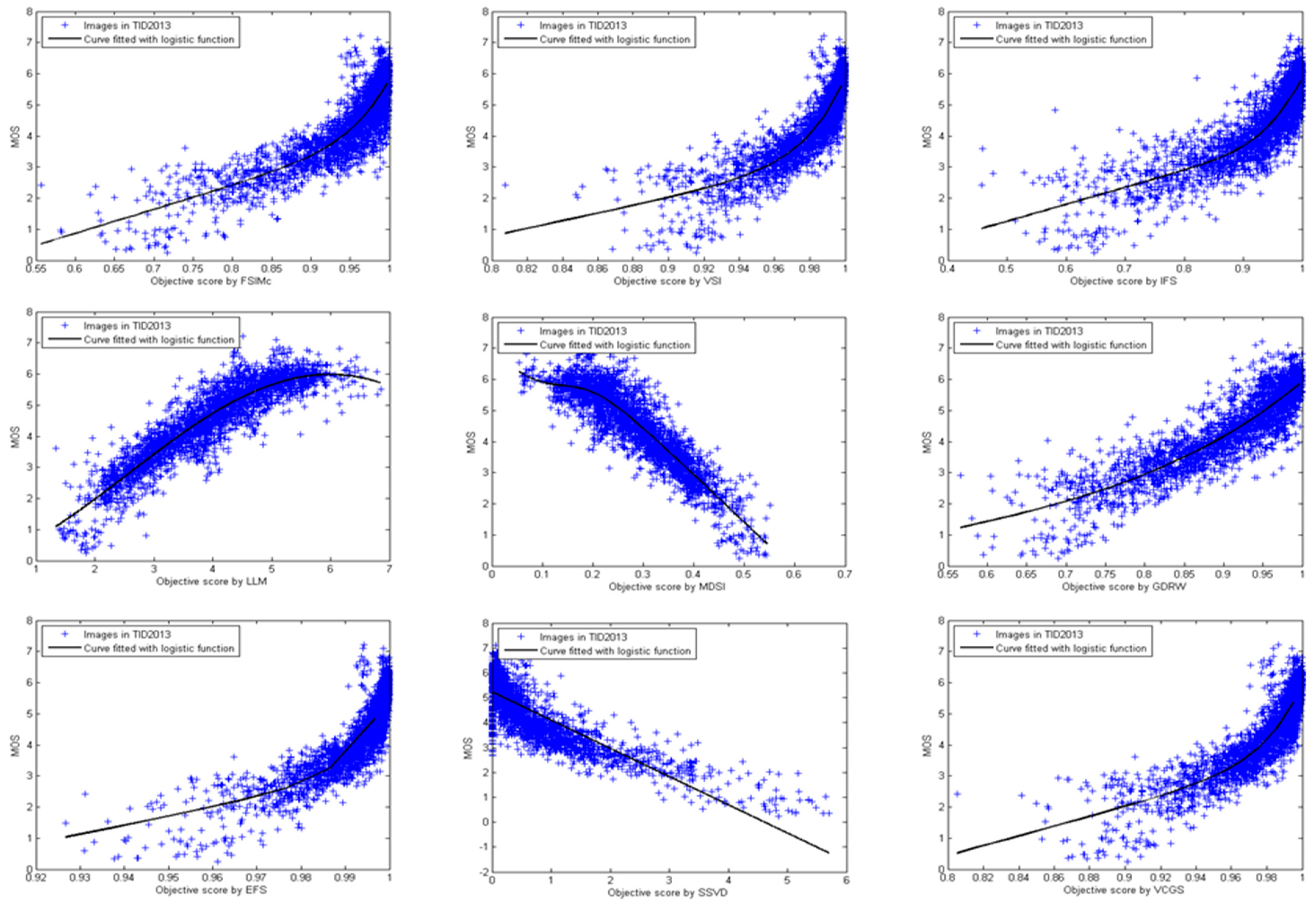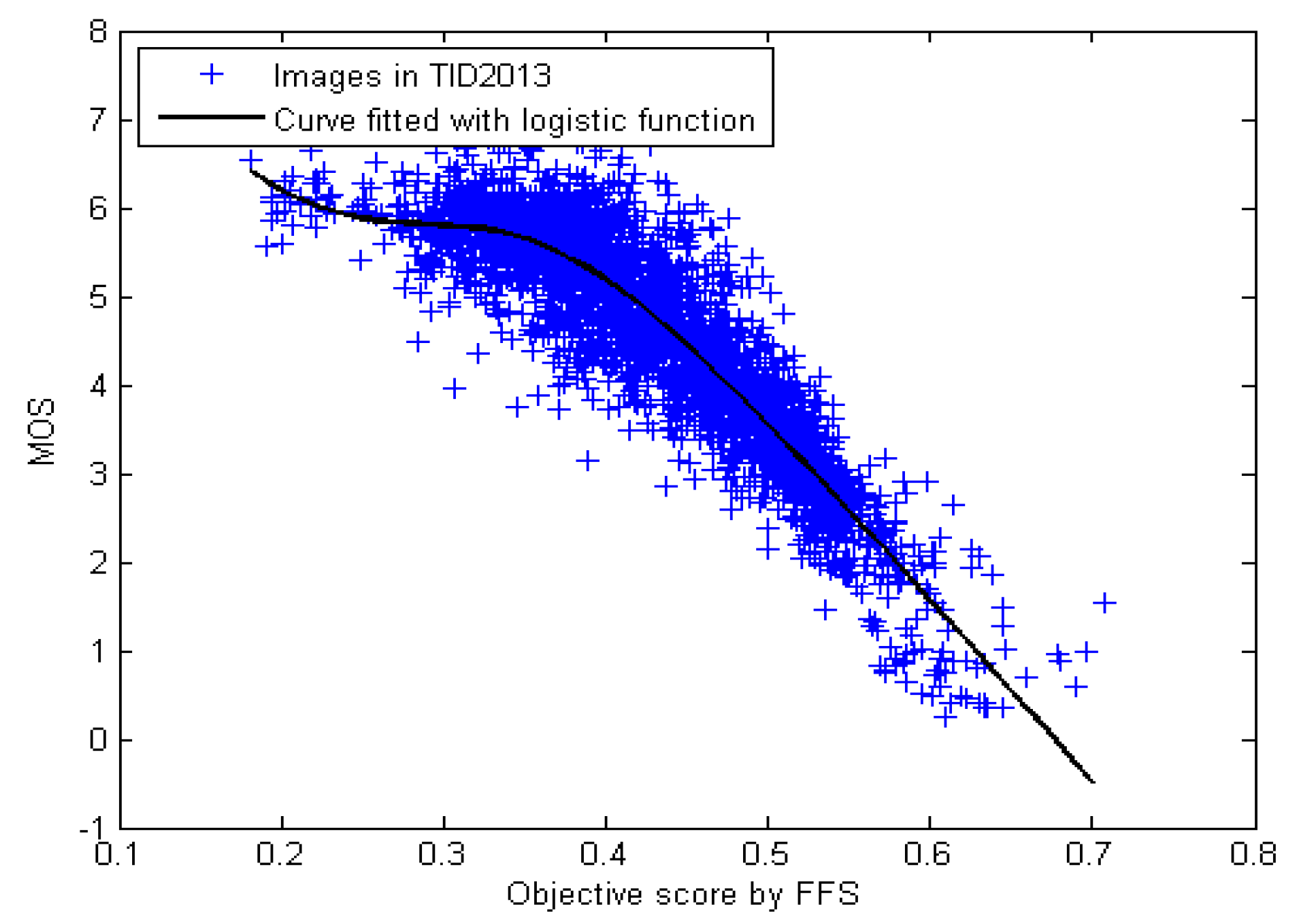1. Introduction
Perceptual image quality assessment (IQA) has become an important issue in many fields and applications [
1], for instance, image acquisition, transmission, compression, and enhancement. To assess image quality, massive objective IQA methods have been designed in the last few decades [
2]. Among IQA methods, the most developed are the methods that compare all the information of processed (distorted) images to the original (reference) image in a symmetric way; these are called Full Reference IQA (FR-IQA) methods [
3]. According to the availability of the reference image, all of the IQA methods can be categorized into three main well-established types: (1) full reference (FR) [
4,
5], (2) reduced reference (RR), and (3) no reference (NR) IQA methods [
6]. The main scope of this research is FR-IQA. The most reliable method for IQA is based on human opinion scoring because the human visual system (HVS) is a perfect image information analyzer [
7,
8]. However, since psycho-visual experiments under standard protocols are laborious, human opinion scoring is infeasible [
9]. To solve these problems, some objective IQA methods are designed to predict human observer ratings. Human observer ratings are always of two types: mean opinion scores (MOSs) and difference mean opinion scores (DMOSs) [
10].
For the IQA methods, the conventional methods are mean squared error (MSE) and peak signal-to-noise ratio (PSNR). These methods were widely used because of their simplicity [
11]. However, their accuracy is not as good as their efficiency because these two methods ignore the visual mechanism of the HVS. Hence, numerous IQA methods have been developed by mimicking the HVS to achieve outstanding performance. The representative method for assessing image quality is the structural similarity (SSIM) method. SSIM was proposed based on the assumption that the HVS is more sensitive to structure information [
12]. Although the accuracy of SSIM is better than MSE and PSNR, it needs to be improved to meet practical demands. Recently, learning-based methods have been proposed. The independent feature similarity (IFS) method was introduced by Chang et al. and it consisted of feature and luminance components [
13]. A FastICA (fast independent component analysis) algorithm was selected to train data via IFS methods [
14]. In addition, Wang et al. proposed a local linear model (LLM) to process IQA by using a convolutional neural network (CNN) [
15]. These kinds of methods have represented another direction for FR-IQA method development. Although these learning-based methods can reach higher prediction accuracies, they are over-reliant on training data.
Additionally, many IQA methods have been proposed using different types of image feature extraction. The feature similarity index (FSIM) [
16] was proposed by combining phase congruency (PC) and gradient magnitude (GM) similarity maps to calculate IQA scores. A mean deviation similarity index (MDSI) [
17] was proposed by using gradient and chrominance fusion similarity. In MDSI, the pooling strategy was chosen as a deviation calculation based on the Minkowski pooling method. Recently, single-value decomposition (SVD) has become a useful tool to assess image quality and structure SVD (SSVD) was proposed [
18]. These three IQA methods pay more attention to grayscale image features, so they cannot be used to assess color images. An improved SPSIM (SuperPixel-based SIMilarity) method can compute similarity maps via MDSI calculations by means of a YCrCb color space [
3]. Therefore, MDSI calculation has been proved to be suitable to deal with color image feature computing. In addition, visual saliency has been a hotspot in image processing research and some state-of-the-art IQA methods have been proposed.
Visual saliency has become an effective feature for IQA because a visual attention receiver of suprathreshold distortions can express how “salient” a local region of an image is to the HVS. Some IQA methods have been proposed based on the influence of visual saliency on image quality and have achieved better prediction results. In [
19], a saliency detection index in the spatial domain was introduced based on the spectral residual (SR) of an image in the spectral domain, namely, the SR visual saliency index. Based on the SR visual saliency index, a spectral residual based similarity (SR-SIM) IQA method was proposed [
20]. This method was designed to deal with grayscale images and cannot reflect the real HVS, since the visual detector receives color information. Therefore, a good objective IQA method should take chromatic components into consideration in feature-extracting procedures. In [
21], visual saliency, which was processed based on SDSP (saliency detection by combing simple priors), was integrated with gradient and chromatic features in the visual saliency-based index (VSI) in LMN color space. Hence, VSI yielded a better performance than SR-SIM by considering the chrominance distortion.
Recently, the visual saliency feature has played an important role in IQA methods. In [
22,
23], SDSP was chosen as the visual saliency extractor for global and double-random window similarity (GDRW) and edge feature-based image segmentation (EFS). The efficiencies of the methods using SDSP are not as good as their accuracies. Shi et al. proposed an IQA method combining visual saliency with color appearance and gradient similarity (VCGS) [
9]. In VCGS, visual saliency was computed by applying a log-Gabor filter on two new color appearance indices in CIELAB color space. Although CIELAB is more closely related to the HVS, the transforming time from RGB to CIELAB took almost half the time to obtain the evaluation results. To achieve a better performance with the subjective evaluation scores, a visual saliency feature can be thought as an indispensable component of an IQA method. Moreover, an IQA method based on gradient, visual saliency, and color information (GSC) has been proposed. With this method, just the gradient feature was calculated via MDSI computing [
24].
Based on the above analysis, transforming an RGB image into other color spaces to extract features is more relevant to the HVS. MSDI calculation is a useful measurement tool for image feature computing to achieve higher correlation coefficients and efficiency.
In this article, a reliable FR-IQA method involving similarity calculation is developed without learning. The proposed method connects three feature information processing components, i.e., visual saliency, gradient, and chromatic features, by using an MDSI fusion strategy in LMN color space. This fusion strategy consists of three fusion steps and these three fusion steps include luminance channels fusion, similarity maps fusion, and features fusion. After some experimental comparisons with the other outstanding methods, the proposed method is shown to be less complex and to offer better quality predictions.
4. Conclusions
In this research, a novel FR-IQA method with good performance was proposed, namely, the features fusion similarity (FFS) method. This method consists of three fusion steps, i.e., luminance fusion, similarity maps fusion, and features fusion. Firstly, the luminance channels of two images are fused with a fusion weight for SR and gradient features enhancement extraction. Secondly, the reference image, the distorted image, and fusion map were calculated by means of a SR similarity fusion map, a gradient similarity fusion map and a chrominance similarity fusion map in a symmetric way, respectively. Lastly, these three feature similarity maps were fused with different weights based on the HVS mechanism and then a deviation pooling strategy was selected to process the features fusion map to obtain an image quality score. After the IQA method design, the main parameters were defined by optimization tests. Twelve state-of-the-art or newly published IQA methods were selected as methods to put in competition with the proposed method with respect to four popular databases. The experimental results showed that the accuracy PLCC value of FFS can achieve at least 0.9116 and at most 0.9774 for the four databases. The time cost of the proposed method is about 0.0657 s. These comparative results illustrated that FFS yields statistically better predictive accuracy than the other methods with a higher computational efficiency. In the future, all IQA methods need to be improved to yield a better performance for the IQA problem in real settings, including the proposed method.
